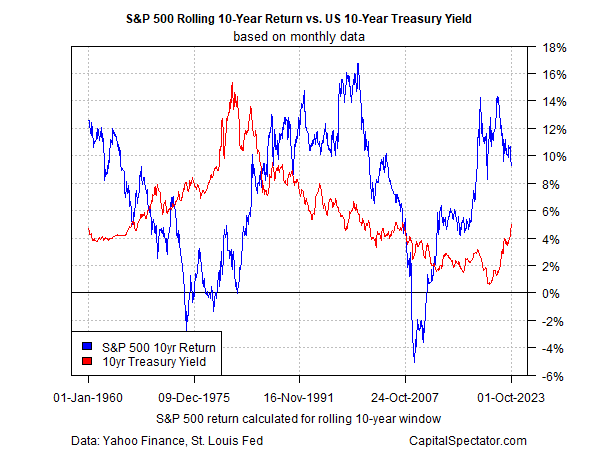The briefly crossed above the 5% mark yesterday — the highest since 2007 — before settling at 4.98%, based on Treasury.gov data.
For buy-and-hold investors, the elevated yield looks compelling, at least relative to recent years, when interest rates were much lower. But the better question is:
How does a 5% yield compare with US stock market performance?
The answer depends on several assumptions, starting with the time frame. You can torture equity returns to say anything you want by changing the time window, so thoughtful analysis is critical here.
As a first step (but far from the last word on the topic), let’s compare how the 10-year yield has fared vs. the rolling 10-year return for the . As the chart below shows, there’s a wide variety of results, depending on the date.

S&P 500 Returns vs 10 Yr Yield Returns
At the moment, the 4.98% yield contrasts with the S&P’s 9.3% annualized return for the trailing 10 years. It’s no surprise that stocks outperform a 10-year yield, but not always. But the fact that you can now lock in a bit more than 50% of the equity market’s trailing 10-year return with no risk (ignoring inflation) is a big change (in favor of the 10-year Note) vs. recent history. The implication, one could argue: it’s timely to raise the portfolio weight in bonds vs. stocks, at least for relatively conservative investors.
Actually, the chart above is a bit misleading because it compares real-time data without a lag. In other words, you earned 9.3% in the stock market over the past decade, but the 4.98% Treasury yield is prospective. The second chart below adjusts for this by comparing how the 10-year yield at any given point in time stacks up against the 10-year return for the S&P 500 over the subsequent decade.

S&P 500 Returns vs 10-Yr Lagged Yield Returns
If you bought and held a 10-year Treasury Note a decade ago you would earned roughly 2.6%, far below the 9.3% trailing 10-year return for stocks.
What will stocks earn for the next 10 years and how will that compare with the expected 5% return for a 10-year Note today?
No one knows, of course, since equity performance can and will vary widely. For good or ill, there’s no shortage of equity forecasts.
“For the next three to four months, what can I say? For the next three to four years, it’s hard to tell how the market will adjust to all the debt,” says. “But for the next 30 years? I see 8% to 9% returns in U.S. stocks.”
That’s in line with CapitalSpectator.com’s current forecast for US stocks. Deciding if these estimates will be accurate is another question entirely, and so caveat emptor.
One thing, however, is clear. Government bond yields are substantially more competitive today vs. the recent past. That’s hardly a crystal ball, but it’s still useful for managing expectations and designing portfolio strategies.

